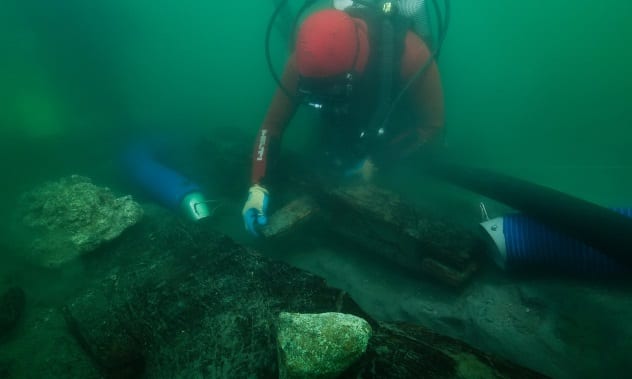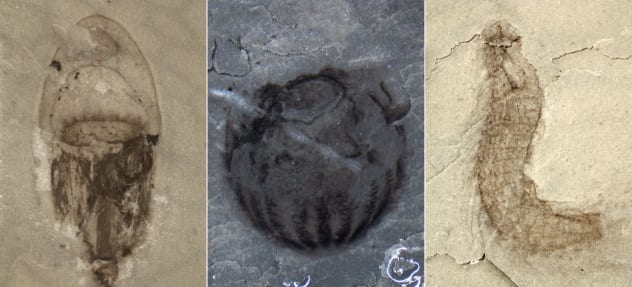 Politics
Politics  Politics
Politics  Weird Stuff
Weird Stuff 10 Eggs-traordinarily Odd Eggs
 History
History 10 Desperate Last Stands That Ended in Victory
 Animals
Animals Ten Times It Rained Animals (Yes, Animals)
 Mysteries
Mysteries 10 Devastating Missing Child Cases That Remain Unsolved
 Creepy
Creepy 10 Scary Tales from the Middle Ages That’ll Keep You up at Night
 Humans
Humans 10 One-of-a-kind People the World Said Goodbye to in July 2024
 Movies and TV
Movies and TV 10 Holiday Movies Released at Odd Times of the Year
 Politics
Politics 10 Countries Where Religion and Politics Are Inseparable
 Weird Stuff
Weird Stuff 10 Freaky Times When Famous Body Parts Were Stolen
 Politics
Politics The 10 Most Bizarre Presidential Elections in Human History
 Weird Stuff
Weird Stuff 10 Eggs-traordinarily Odd Eggs
 History
History 10 Desperate Last Stands That Ended in Victory
Who's Behind Listverse?

Jamie Frater
Head Editor
Jamie founded Listverse due to an insatiable desire to share fascinating, obscure, and bizarre facts. He has been a guest speaker on numerous national radio and television stations and is a five time published author.
More About Us Animals
Animals Ten Times It Rained Animals (Yes, Animals)
 Mysteries
Mysteries 10 Devastating Missing Child Cases That Remain Unsolved
 Creepy
Creepy 10 Scary Tales from the Middle Ages That’ll Keep You up at Night
 Humans
Humans 10 One-of-a-kind People the World Said Goodbye to in July 2024
 Movies and TV
Movies and TV 10 Holiday Movies Released at Odd Times of the Year
 Politics
Politics 10 Countries Where Religion and Politics Are Inseparable
 Weird Stuff
Weird Stuff 10 Freaky Times When Famous Body Parts Were Stolen
10 Offbeat Stories You Might Have Missed This Week (3/23/19)
With another week in the history books, it’s time to sit back and review some of the peculiar stories that made the news over the last few days. If you’d rather know about recent good news in the world, you can click here.
There are tales of gators on ketamine and the world’s most expensive pigeon. There are two stories regarding discoveries from shipwrecks, and staying on the subject of history, we pay a quick visit to the town of Bedrock for a yabba-dabba-doo time. Jack the Ripper claimed a few headlines this week, as did an uninvited guest from space.
10 Saucy Jack Is Back

It has been 130 years since Jack the Ripper’s killing spree, but he is still garnering plenty of attention. A new study published in the Journal of Forensic Sciences claims that DNA from a shawl alleged to have belonged to one of the victims has finally revealed the identity of Jack the Ripper.
The authors are Jari Louhelainen of Liverpool John Moores University and David Miller of the University of Leeds. They say that Jack was a Polish barber named Aaron Kosminski. The reveal itself isn’t too shocking. Kosminski has always been considered one of the more likely Ripper suspects. The scientists claim that mitochondrial DNA found on a shawl which is said to have belonged to Catherine Eddowes matches that of Kosminski’s modern descendants.
This proclamation has not been well-received by the scientific community, who have deemed it “unpublishable” and “terrible science and terrible history.”[1] For starters, geneticist Adam Rutherford pointed out that the testing had been done in 2014 and had already been heavily criticized but, for some reason, has now made its way into a scientific journal. Other geneticists such as Turi King from the University of Leicester voiced concerns over contamination. Even if the shawl belonged to Catherine Eddowes (which is definitely not a certainty), it has been handled with carelessness by many people throughout the decades. It seems probable that Jack the Ripper’s identity still eludes us.
9 A Pigeon Worth His Weight In Gold

A pigeon called Armando set a new record after being sold at auction for €1.25 million ($1.42 million).
The previous record was €376,000 ($426,000). Auction house Pipa, which specializes in selling racing pigeons, knew that Armando would fetch a great price. He had been touted as the “Lewis Hamilton of pigeons.”[2] However, they expected the bids to top off around half a million euros, maybe €600,000 max. Never in their wildest dreams did they think Armando would be sold for over double that amount. The giant price tag was the result of a bidding war between two Chinese buyers.
So what’s so special about Armando? He is regarded as one of the greatest racing pigeons of all time. His competing days are behind him, though. Armando will turn five this year, and he has retired from racing. However, he is still capable of producing many offspring to carry on his legacy.
8 Shipwreck Ale

Beer aficionados have a new drink to try. It is called Deep Ascent ale, and it is made with yeast from a century-old shipwreck.
The SS Oregon was once the fastest liner traveling the Atlantic. Alas, it sank in 1886 after colliding with a schooner a few miles from New York in an area known today as “Wreck Valley.”
As the name implies, quite a few vessels went down in that region, which has become a popular spot for scuba divers. One of them is Jamie Adams, a former Wall Street trader who now operates the Saint James Brewery in Long Island. He got the idea that if he could find a few intact bottles, he could recreate the beers from over 130 years ago.
Adams first tried his luck in 2015 without success. It wasn’t until 2017 that he got his hands on some pristine beer bottles after shifting sands opened access to the ship’s dining room. It took him another two years and the help of a microbiologist to extract the yeast and then use it in a modern ale.[3] The finished product is a beer that Adams describes as having a “slightly fruity taste and hoppy finish.”
7 Last Blockbuster On Earth

The city of Bend, Oregon, will soon have a strange claim to fame: It will be the home of the last Blockbuster on the planet.
At the moment, there are two of these video rental shops remaining. One is in Bend, and the other is in Morley, a suburb of Perth, Western Australia. However, the latter will close its doors permanently at the end of March, thus leaving the store in Oregon as the last Blockbuster standing.
The American shop was once part of a five-store franchise owned by the same family, but all the other Blockbusters were closed down. General Manager Sandi Harding believes this one survived through “pure stubbornness,” but it also required running on a very tight budget. The computer system uses floppy disks to reboot, while business transactions are stored on reel-to-reel tape. Employees write out membership cards by hand because the dot-matrix printer they once had broke.[4]
These measures might have been implemented to keep costs down, but now they are actually working in the store’s favor. More and more customers are stopping by looking for a hefty dose of nostalgia.
At its height, Blockbuster had over 9,000 locations across the world. It also had a chance to buy Netflix for a “paltry” $50 million, but it passed on the opportunity. It went bankrupt in 2010, but some stores had been franchised and stayed open.
6 Herodotus Was Right

Almost 2,500 years ago, Herodotus wrote The Histories, one of the most influential works of literature of the ancient world. Included in the texts was an account of his visit to Egypt. One passage puzzled scholars. It described, in detail, a ship called a baris with “long, internal ribs.” Herodotus witnessed it being built, but archaeologists never found any evidence that such a vessel ever existed. But now they’ve actually found one “fabulously preserved” near the sunken city of Heracleion.
Herodotus described the baris as having planks inserted into strong, long tenons and then beams stretched over them. The seams are obstructed from within with papyrus, and there is one rudder which passes through a hole in the keel. The mast is made from acacia and the sails from papyrus.
This form of construction has never been seen until now. The so-called “Ship 17” had acacia planks which were held together with long tenons and fastened with pegs.[5] This created a hull made out of the “internal ribs” mentioned by Herodotus.
Ship 17 is one of 70 ancient vessels found around the underwater ruins of Thonis-Heracleion which now sit in Abu Qir Bay. Approximately 70 percent of the hull still survives, and it matches the description given by Herodotus almost word-for-word. No telling yet if there is another baris among the other shipwrecks.
5 Gators On Ketamine Provide Insight Into Sound

In a study published in the Journal of Neuroscience, researchers drugged alligators with ketamine and played them sounds through headphones in an attempt to better understand the auditory systems of archosaurs.
Catherine Carr from the University of Maryland and Lutz Kettler from the Technical University of Munich performed the experiment so that they could study the “neural maps” that gators use to process the noises around them. They focused on a concept called “interaural time difference” (ITD).[6] Basically, it is the time gap between ears hearing the same sound. It is mostly imperceptible, as it typically lasts for a few microseconds, but it is crucial in helping animals determine what direction a sound comes from.
To perform the test, scientists had 40 American alligators listen to various noises through headphones while electrodes on their heads recorded their neural responses. Of course, gators aren’t known to be the most cooperative animals in the world, so they had to be sedated with ketamine.
An earlier study did something similar with birds, and this latest experiment showed that the two groups use a similar neural mapping system, but also one that is different from mammals. Crocodilians and birds come from an antediluvian lineage called Archosauria, which also included dinosaurs and pterosaurs. Researchers infer that their extinct cousins would have probably had a similar auditory mechanism, especially since the size of the head does not seem to make a difference.
4 Fight Over Flintstone House

The owner of Flintstone House is being sued by neighbors who consider her abode to be a public nuisance.
Back in the mid-1970s, architect William Nicholson designed several experimental dome dwellings. One of them was built in the town of Hillsborough in San Mateo County, California. He gave it its unique shape by placing a mesh frame over inflated aeronautical balloons. The strange, somewhat primitive appearance earned it the sobriquet of “Flintstone House.”
The latest owner is retired media mogul Florence Fang. She embraced the Flintstone identity wholeheartedly and made a few additions. These include multiple dinosaur statues and a sign that says “Yabba Dabba Doo.”[7]
The neighbors were not happy with these new changes. Some of them consider the red, orange, and purple building somewhat of an eyesore, and the dinosaurs are certainly not helping matters. Last fall, a panel of code enforcement officials agreed with them that the latest renovations are a public nuisance, and now they are hoping that a judge will do the same. According to the suit, Mrs. Fang did not have the proper permits to make the changes. In a statement, her grandson Sean Fang said that she will fight to keep the Flintstone House as is.
3 Fossil Find Stuns Scientists

Paleontologists are hailing a fossil deposit in China as one of the most spectacular on the planet.
The site is called Qingjiang, and it is approximately 518 million years old. What makes it truly remarkable is that it contains fossilized soft parts. These are significantly rarer than hard anatomical structures like shells, which get preserved much more easily. The site is already drawing comparisons to the famed Burgess Shale in the Canadian Rockies. As Harvard paleontologist Joanna Wolfe put it, these deposits are “the best of the best.”
Researchers found the treasure trove by chance on the banks of the Qing River, a tributary of the Yangtze, back in 2007. Since then, they have spent four seasons in the field in order to truly get a sense of what they uncovered. They published their findings earlier this week in the journal Science.
So far, scientists have identified the remains of 101 different animal species. Over half of them are completely new to science.[8] Qingjiang will greatly expand our knowledge of the early Cambrian period known as the Cambrian explosion, when life diversified in spectacular fashion in just a few tens of millions of years.
2 The Florida Man Challenge

This week’s viral Internet craze comes to us courtesy of that mysterious, misunderstood individual we call Florida Man. The “Florida Man Challenge” involves people searching to see what kind of wacky shenanigans our intrepid hero had been up to on their birthday and then sharing the result on social media.
Taking part in the trend is easy. All you have to do is google the words “Florida Man” followed by your birthday (just the month and day). The first headline is your “Florida Man” story. If your birthday was the day this article was written, for example, you would discover that on your anniversary, Florida Man was “attacked by neighborhood squirrel who has residents on high alert.”
This renewed interest into the odd behavior of the residents of Florida has prompted new discussions into its likely causes. Assistant State Attorney Ryan Butler points to open government laws that make all documents a matter of public record by default, unless directed otherwise. This makes it much easier for journalists to report on crime stories.[9]
Some opine that it is due to the cyclical nature of the “Florida Man” myth. The popularity of the meme encourages more sharing of strange crimes from Florida than other states, which, in turn, further enhances the myth and so on. Lastly, there are those who simply admit that there is a “general craziness” pervasive in the state.
1 When Meteors Attack

NASA revealed that a giant meteor exploded in Earth’s atmosphere in December. Despite creating a massive fireball, it went largely undetected because it blew up over the Bering Sea.
The space rock approached our planet on December 18, traveling at a speed of 30 kilometers per second (19 mps). It burst into a ball of fire roughly 25.5 kilometers (16 mi) above the cold waters between Russia and Alaska. NASA’s Center for Near Earth Object Studies later calculated the force of the explosion to be 173 kilotons, which is more than eleven times as energetic as the bomb at Hiroshima. Even so, it was only 40 percent as powerful as the blast over Chelyabinsk in 2013.
Unlike the Russian meteor, however, this one did not cause any injuries or property damage. In fact, we almost didn’t notice it. There were various institutions that had instruments which recorded the explosion, but it wasn’t until March 8 that the US Air Force informed NASA of the event so that they could log the fireball into their database.[10]
The space rock was approximately 10 meters (33 ft) in diameter. It was “nothing very unusual,” according to Rudiger Jehn, head of planetary defense at the European Space Agency (ESA). The event has renewed calls for increased budgets for planetary protection systems.
Read more offbeat stories you might have missed from March 16, 2019, and March 9, 2019.








